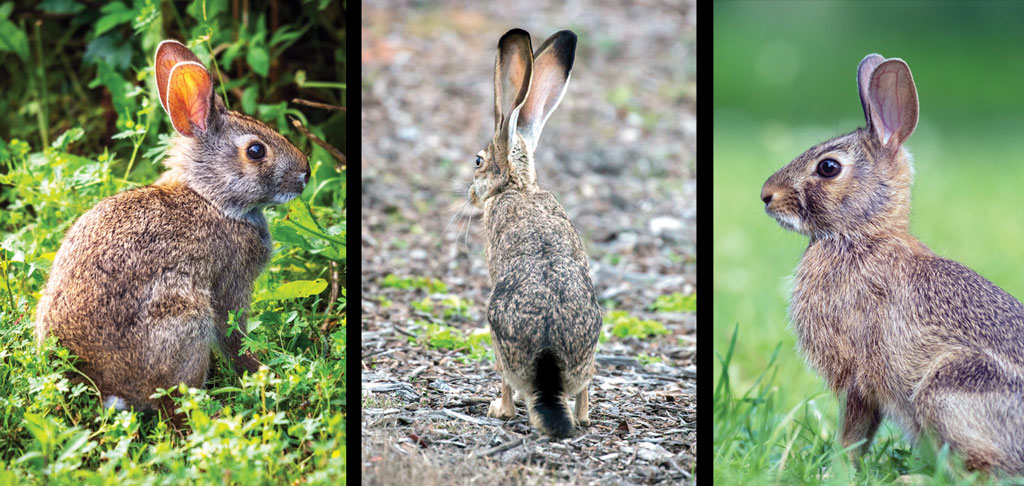
LEFT: Swamp rabbits often take to the water to escape a threat. They are known to submerge themselves with only a nose above water in hopes of eluding a predator. CENTER: Black-tailed jackrabbits have ears nearly as long as their hind feet. The ears have black tips and the tail has a black area that extends onto the rump. Mature females can have 2-4 litters a year with 4-6 young per litter. RIGHT: Eastern cottontails, unlike jackrabbits, prefer the shelter of brushy cover. They typically hop slowly, freezing in place ever so often to check their surroundings for predators. Eastern cottontails rely on camouflage and cover to stay out of harm’s way.
With spring's arrival each year comes thoughts of Peter Cottontail hopping down a bunny trail, but wait — was that Peter Cottontail? Or, could it be his cousin Nutbrown Hare? Don’t jump to conclusions.
Rabbits in Texas behave more like hares, yet we call our hares rabbits. The state has five species of lagomorphs (rabbits and hares), but only three are typically found in Central Texas: black-tailed jackrabbit, swamp rabbit, and eastern cottontail. Two of these are rabbits and one is a hare — can you guess which one is the hare? We’ll let you chew on that for a bit, Doc.
Many mistakenly believe rabbits and hares are synonymous. They are not. They are two different species, although very similar.
Obviously, both hop, have long ears, two large front teeth, and are herbivores. They also share a few other not-so-obvious traits.
Being crepuscular (active at twilight), they have excellent night vision, sense of smell, and hearing. They are coprophagic, poop-eaters so to speak. They digest food twice. Lagomorphs have two types of droppings: fecal pellets (hard, light brown balls) and cecal pellets (soft, green-brown clusters). Eating the cecal pellets provides the healthy bacteria needed for digestion.
Female rabbits and hares ovulate after mating and can become pregnant again just days after giving birth. They make similar sounds — some by grinding their teeth and thumping their back legs. They purr, cluck, growl, hiss, whine, scream, grunt, and thump.
With so much in common, the difference between rabbits and hares might seem a bit fuzzy. The key differences between the two are size and the development of their young at birth.
Hares are larger with longer ears, longer hind legs, and a slightly larger body. As a result, they are faster than rabbits.
Rabbits live in a nest at birth; hares do not. Developmentally, baby hares, called leverets, are leaps ahead of baby rabbits. Leverets are well-developed and fully furred at birth and can even hop just a few hours after being born. Baby rabbits, or kits, are born hairless and blind and aren’t able to hop for another two weeks.
Out of the three lagomorphs typically found in Central Texas, the black-tailed jackrabbit is the lone hare. Our two native rabbits, both cottontails, act more like hares. Unlike other rabbits, cottontails live above ground and do not dig holes or live in groups.
The eastern cottontail is the most common rabbit around and can easily adapt to various habitats. This reddish-brown rabbit has a cotton-like tail and is a notorious breeder, producing 3-5 litters of 4-8 kits each year. When faced with danger, they flee in a zig-zag pattern. Continuously on guard, the eastern cottontail twitches its nose from 20-120 times per minute. Sense of smell is one way lagomorphs check for danger.
The largest cottontail, the swamp rabbit, is found along rivers and streams in Central Texas and is a very good swimmer. When fleeing a predator, they can submerge underwater with only a nose sticking out. These rabbits have cinnamon-colored rings around the eyes, a yellowish cast to their very dense fur, shorter more rounded ears, and a less obvious tail. Swamp rabbit babies, like hares, are born with fur. Unlike hares, they are born blind.
Black-tailed jackrabbits are typical hares (except for the name). They prefer to live in pastures, brushlands, and meadows where they can spot predators before predators spot them. The jackrabbit has very long, black-tipped ears and long, lanky legs. It's bigger and faster than a rabbit, and speed is its first line of defense — some can run up to 40 mph for short distances. It will flash the white underside of its tail to warn other jackrabbits of danger.
Now that you have the poop on rabbits and hares in the Highland Lakes, here are a few fun facts to kick around:
- Lagomorphs’ teeth continue to grow about 1 centimeter a month throughout their lives. Since they grind their teeth when eating, the length is kept in check.
- Their long ears are full of blood vessels that dilate on hot days, helping them cool off.
- Rabbits symbolize good luck, peace, and fertility.
- Rabbits and hares are both considered prey species. Their defense mechanisms are kicking and biting.
- Having eyes on the sides of their head allows them to see nearly all the way around their body.
- The name jackrabbit was bestowed on this hare by early settlers who likened its very long ears to those of the jackass.
- Rabbits and hares have about 100 million scent receptors in their noses. Humans have 400.
- Only about 15 percent of rabbits and hares reach adulthood.
- The other two cottontail species in Texas are the Davis Mountains cottontail and the desert cottontail.
- The jackrabbit population tends to peak every seven years.
IN THE NEWS
The Texas Parks and Wildlife Department reported in February the first cases of RHDV2, a second strain of rabbit hemorrhagic disease, in Gillespie County. This almost-always-fatal virus affects wild rabbits and hares. The virus first appeared in West Texas but seems to have recently made its way to the Hill Country. The department urges anyone who notices sick or dead wild rabbits to contact a local TPWD wildlife biologist.
jgreenwell@thepicayune.com












